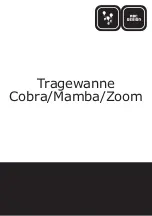
Table of Contents
2
Overview
Mounting
Wiring
Indication and Controls
Program Levels
Level 1 (User Level)
Program Level 2
Program Level 3 (I)
Program Level 3 (II)
Program Level 3 (III)
Output Control
Alarm modes
Communication
Error Messaging
EMI Issues
Declaration of Conformity
Waste Disposal
Specifications
Warranty and Support
3
3
4
5
6
7
8
9
10
11
12
13
14
14
15
15
15
16
16
Electro-Magnetic Interference (EMI) Issues
15
Important note:
RT1900 may content a
RC noise suppression
circuit is connected in
parallel with relay
contacts.
Full AC voltage isolation
is NOT provided when
relay contacts are open.
Small AC current
(≈ 1.5 mA at 230 VAC)
still flows through
the RC circuit!
♦
All signal wires must be shielded. They must
not be packaged together with power cables!
♦
Never lay the signal wires close to inductive or
capacitive noise sources, such as relays,
contactors, motors, etc.!
♦
All shields have to be grounded ONLY at one
end, as closer as possible to device terminals!
♦
Avoid sharing supply lines with powerful
consumers, especially with inductive loads,
switched on and off.
♦
To stop unwelcome interference signals
entering through the power supply lines,
use shielded 1:1 isolation transformer!
♦
Shunt all switched (not only those switched
by the indicator) inductive consumers with
special suppression networks: RC group and
varistor - for AC loads, or diode - for DC loads.
♦
If the indicator operates in a very powerful
EMI area, it has to be mounted inside
a grounded metal shielding box!
Declaration of Conformity
We hereby declare that this device has been
manufactured in compliance with standards
EN 61000, EN 61010 and EN 61326,
and meets the requirements of Directives
2004/108/EC, 2006/95/EC and 2011/65/EC.
Vladimir Sakaliyski, CEO
COMECO Inc.
Waste Disposal
Do not
dispose of
electronic
devices
together with
household
waste!
If disposed of within European Union,
this product should be treated
and recycled in accordance with the laws
of your jurisdiction implementing
the WEEE Directive 2002/96
on the Waste Electrical and Electronic Equipment.
Wiring
4
Gently remove transparent plastic
protectors from terminal blocks prior wiring!
Install the protectors again when finish!
Input signal wiring
♦
Connect Pt100 sensors to terminals
9, 10 and 11, or T/C sensors to
terminals 9(-) and 10(+).
♦
Connect linear mV/V signal to
terminals 9(-) and 10(+).
♦
Connect linear mA signal to terminals
9(-) and 10(+) paralleled with
enclosed 2.5
Ω
external resistor.
♦
Transmitters must be powered from
external sources!
Serial interface wiring
Connect RT1900-R to RS485 interface
line via terminals 12(Dx-) and 13(Dx+).
Output wiring
♦
Connect relay, SSR and MOS gate
outputs to the respective terminals
3...8 as shown on the left figure.
♦
Connect analog outputs and external
SSRs to the respective terminals 3...8
as shown on the left.
Power supply wiring
Connect the power supply voltage
to terminals 1(L) and 2(N).
Alarm modes
13
Table 2 (Alarm modes)
Alarm function
Alarm action is suppressed at start-up
until PV enters non-alarm range!
Alarm action is suppressed at start-up
until PV enters non-alarm range!
Alarm action is suppressed at start-up
until PV enters non-alarm range!
Alarm action is suppressed at start-up
until PV enters non-alarm range!
Alarm action is suppressed at start-up
until PV enters non-alarm range!
Alarm modes with their type and codes
(referenced to
ALd1
,
ALd2
,
ALd3
):
Code
Description
00/10
No alarm
11
Relative HIGH alarm
Deviation from SV high alarm
01
same as code 11,
but with suppression
12
Relative LOW alarm
Deviation from SV low alarm
02
same as code 12,
but with suppression
13
Window alarm
Deviation from SV high/low
alarm
03
same as code 13,
but with suppression
04/14
Band alarm
Deviation from SV
15
Process HIGH alarm
Exceeding absolute value
05
same as code 15,
but with suppression
16
Process LOW alarm
Falling below absolute value
06
same as code 16,
but with suppression
08
System alarm ON
Activating at errors
UUU1
,
nnn1
or
CJCE
18
System alarm OFF
Not activating at above errors






















